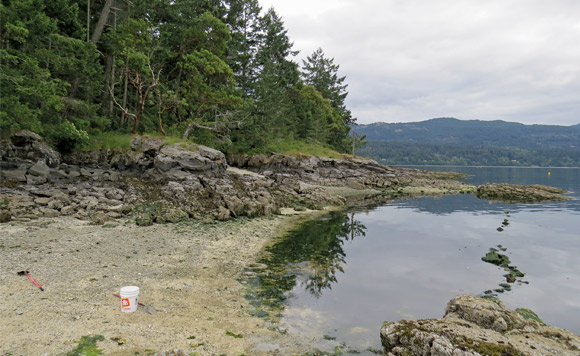by Tina Kelly –
Long, long before your fruit and veggie waste digested into soil in the back yard, and long before the curbside kitchen scrap program, there were traditional compost heaps among us. These ancient kitchen heaps, or middens, are now considered archaeological sites; there are 5,700 known midden sites in British Columbia with more than 30 right here in the Gulf Islands.
Midden, an English word of Scandinavian origin, describes a location for food waste disposal. The composition of local middens offers a peek into the lives and historical diets of First Nations peoples. While inland First Nations may have relied on hunting land mammals resulting in middens of bones, coastal First Nations accessed the sea.
“When the tide is out, the table is set,” say some coastal First Nations. A veritable buffet is accessible during low tide and in some locations, the archaeological midden evidence points to a diet rich with clams. One of these shell middens is visible on Sidney Island; years of dust, dirt and sand covering the deep pile of shells is slowly being worn away and exposed by wind and waves.
The flat, soft, sandy expanses on Sidney Island’s northeast side are perfect habitat for many clam species including cockles, bent nose clams and horse clams. Coastal habitats in the Gulf Islands consisting of sand, pebble, cobble and boulders are also home to a variety of bivalve species – like butter and littleneck clams – but with a steeper gradient, the area of suitable and accessible clam habitat can be greatly reduced. To increase this area, First Nations engineered a boulder wall across the low-tide line and parallel to the beach. The landward side of the wall then fills with sediment, creating a flat surface at the perfect tidal range (mid to lower intertidal) for growing clams. These areas are referred to as clam gardens and, much like you tend your veggie patch, First Nations tended these clam gardens to increase the size and abundance of clams. This process of gardening clams may have increased clam production by as much as 400%.
Salt Spring and Russell Islands both feature remnants of historical clam gardens. Parks Canada’s Clam Garden Restoration Project was formed in 2014 to rebuild, study and conserve the areas within and around these gardens. This process has proceeded through a partnership between local First Nations – Hul’q’umi’num and WSÁNEĆ – and Parks Canada. This multi-year project combines science and traditional knowledge. An added benefit is the ability for the First Nations community to come together for knowledge sharing between Elders and youth.
In this case, when the tide is out, the dinner table and the classroom are set.
Note: If you stumble across, or have the opportunity to visit, a midden site, please respect its archaeological significance and keep hands and feet away from disturbing the area.
To learn more about the Clam Garden Restoration Project visit Parks Canada at www.pc.gc.ca.




